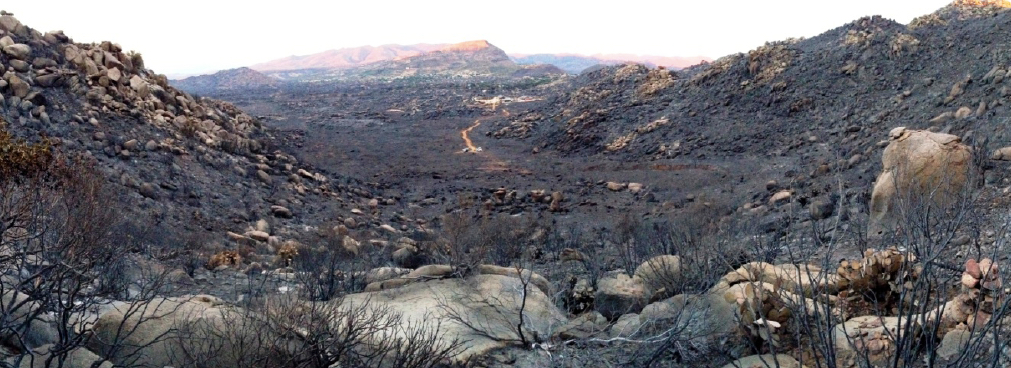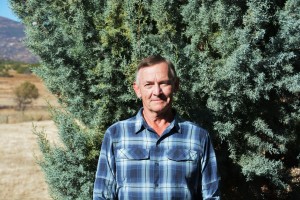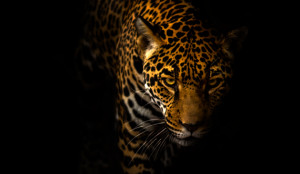Chapter I, Chapter II, Chapter II supplement, Chapter III, Chapter IV, Chapter V, Chapter VI, Chapter VII, Chapter VIII , Chapter IX, Chapter X, Chapter XI, Chapter XII , Chapter XIII, Chapter XIV, Chapter XV, Chapter XVI, Chapter XVII, Chapter XVIII, Chapter XIX and Chapter XX.
Wildfire expert alleges state coverup on eve of hotshot families’ Yarnell field trip

The burned over box canyon where 19 Granite Mountain Hotshots were killed on June 30, 2013. Photo by Arizona Forestry Division
A long anticipated field presentation scheduled Tuesday by the state Forestry Division for the family members of the 19 Granite Mountain Hotshots that will take survivors to the site where their loved ones died is being sharply criticized for failing to accurately portray what happened.
The Yarnell site visit uses a military “staff ride” format where participants are taken to different locations on the fire ground and wildfire experts provide presentations on the best available information about the events that led up to the deaths of the Granite Mountain Hotshots on June 30, 2013 at the Yarnell Hill Fire. A “facilitator guide” has also been prepared that provides detailed information about key events in the days before and on the day of the fire.
The tour and presentation is touted by the state as a way to provide the families facts about the fire and offer an opportunity for a healing experience.
“This product is a true legacy of your loved one that will educate firefighters across the nation and put them in the shoes and decision making process’ of the Granite Mountain Hotshots,” Don Boursier safety and logistic officer for the Arizona Forestry Division, states in a Feb. 25 email to family members.
But one of the nation’s leading wildfire fatality experts who has participated in such events in the past is sharply criticizing the information that will be presented to family members as being an inaccurate and misleading portrayal of the events.
“I think the staff ride is an insult to all of their loved ones because it hasn’t yet told the truth,” says Ted Putnam, a retired wildfire fatality investigator and Chino Valley resident who has been conducting an unofficial investigation of the Yarnell Hill Fire. “The biggest tribute we should do for these firefighters is to tell the truth.”
Putnam was provided a copy of the facilitator guide that will be used during the staff ride by InvestigativeMEDIA, which obtained it from the Forestry Division through a request under the Arizona Public Records Law.
Putnam says he has direct information from multiple firefighter sources who were at the fire in conjunction with evidence contained in investigation reports that leave no doubt in his mind that Arizona Forestry Division fire supervisors ordered Granite Mountain to come off the mountain and go to Yarnell.
“I’ve been in this business longer and know more about this than anybody out there and this all screams at me they were ordered off the top (of the mountain),” Putnam says.
Putnam, a former smoke jumper, served as an investigator on high-profile fatal wildfires including the 1990 Dude Fire in Arizona and the 1994 South Canyon Fire in Colorado. Putnam is considered one of the leading experts in wildland fire entrapments and has been cited by many as “the pioneer in advancing scientific knowledge in this area.”
Putnam gained notoriety when he refused to sign the official accident investigation report for the South Canyon Fire where 14 hotshots and smoke jumpers were killed because he believed the report was untrue. Putnam has a Ph.D. in Experimental Psychology from the University of Montana.
Putnam’s claim directly contradicts the official version of events included in the forestry division’s Serious Accident Investigation Report that was released in September 2013, and there is no mention of such an order in the upcoming staff ride documentation.
The SAIR concluded that no one knows why the crew descended from a safe, burned-over area called ‘the black’ on the top of the Weaver Mountains and dropped into a box canyon jammed with drought-stricken chaparral at the hottest time of the day with the wildfire approaching and a massive thunderstorm bearing down.
“No one realized that the crew left the black and headed southeast, sometime after 1604 (4:04 p.m.),” the SAIR report states.
Putnam says the report’s conclusion defies logic. Putnam does not believe that Granite Mountain Hotshot superintendent Eric Marsh would have ordered his crew to leave its safe zone unless he was pressured by superiors to get the crew to Yarnell. At the time the crew moved off the mountain, the fire was sweeping into Yarnell forcing evacuations of many residents.
“Marsh’s action make no sense at all unless he was ordered off the top,” Putnam says.
Putnam says he cannot reveal his sources because they provided the information under the promise of confidentiality. But, Putnam says, he would provide complete details in a trial or other formal setting where he was asked to testify under oath.
State Forestry Director Jeff Whitney requested a meeting early Monday with InvestigativeMEDIA to respond to Putnam’s statements. But Whitney walked out of the interview without saying a word when this reporter began to set up a video camera to record the interview.
A few minutes later, Joy Hernbrode, deputy director of administrative services for the forestry division, agreed to appear on camera.
“I haven’t seen any evidence that supports Mr. Putnam’s claims, so I don’t know what he’s built his belief on,” Hernbrode says. “But we have looked at all the evidence in the state report, the videos, and it is our opinion that there isn’t any evidence that anybody was ordered off that mountain. However, if somebody has evidence of that, we definitely would like to see it.”
Audio evidence has surfaced in records released by the state Forestry Division that show Marsh was communicating about the crew’s movements during a 30-minute period the SAIR states there were no verifiable communications from the crew.
A video clip shot by Blue Ridge Hotshot Ronald Gamble at 4:27 p.m. picks up an audio exchange between an unknown firefighter and Marsh.
While it is difficult to hear clearly the unknown firefighter, it sounds like he is saying, “Copy…coming down and appreciate it if you could go a little faster, but you’re the supervisor.”
Marsh was assigned as a Division supervisor on the morning of June 30, and Steed assumed command of the Granite Mountain crew.
A few seconds later, Marsh replies, “Ah, they’re coming from the heel of the fire.”
Marsh’s widow, Amanda Marsh, confirmed it was her late husband’s voice.
Hernbrode says the video does not prove anybody ordered the crew to leave the mountain.
“I don’t know who he’s (Marsh) talking to,” she says. “More experienced fire folks than I have looked at that and could not conclude that was evidence that anybody ordered them off.”
Additional evidence of communications between Marsh and other unknown firefighters during the reported black out period also surfaced in background audio of an aerial firefighting effectiveness study that was being conducted during the Yarnell Hill Fire. These audio clips were included in the supplemental materials released with the SAIR but never included in the formal report.
The staff ride is required under a June 2015 settlement agreement reached with 12 of the families who had filed a $220 million federal lawsuit against the forestry division. The agreement required the state to pay the 12 families a total of $600,000 and to admit to no wrongdoing.
Among the records released by the forestry division is the Yarnell Hill Staff Ride Facilitator Guide that was prepared for a trial staff ride on Feb. 17-18 and the facilitator guide for Tuesday’s site visit with Granite Mountain families.
OMNA International, a private contractor that specializes in preparing staff rides for wildfire fatality sites as well as military battlegrounds including Gettysburg, prepared the guides under a contract with the U.S. Forest Service, according to Bill Boyd, forestry division public affairs and legislative officer. [Read more…]
Please begin Yarnell Hill Fire Chapter XX here
Arizona Forestry Division releases Yarnell Hill Fire settlement agreement with Granite Mountain Hotshot survivors
In response to a request by InvestigativeMEDIA under the Arizona Public Records Law, the Arizona Forestry Division today released the settlement agreement between the survivors of the 19 Granite Mountain Hotshots who were killed on June 30, 2013 in the Yarnell Hill Fire.
The agreement was reached last summer but was never publicly released.
The agreement calls for the 12 families that filed a federal wrongful death lawsuit to receive $600,000. Survivors signed off on the agreement between July 6 and July 29, 2015.
The Forestry Division made no admission of liability or wrongdoing in its management of the Yarnell Hill Fire that was sparked by lightening on June 28, 2013. The families dismissed “with prejudice” the federal lawsuit they had filed against the forestry division and its employees.
The agreement requires the forestry division to meet with the Granite Mountain Hotshot families for a full day “to review data and information and to answer questions posed by the families and their consultants/experts.”
The agreement also requires the forestry division to create a “staff ride for the Yarnell Hill Fire and will make its personnel and information it has collected available.”
The settlement also lists a number of requests by the families for the forestry division to implement to improve safety for wildland firefighters.
“The Forester agrees to make good faith effort to implement the items…” the agreement states. “However, all Parties recognize that certain actions are dependent on matters outside the control of the Arizona State Forestry Division and the Forester, including items dependent on budget adjustments, legislative action or adoption by national, regional and local partner agencies and organizations.”
The agreement is here.
Documentary exposes how a Canadian miner is seeking to destroy the habitat of the nation’s only known wild jaguar
Rimrock, AZ—InvestigativeMEDIA’s documentary “Flin Flon Flim Flam” reveals the controversial history of Toronto-based miner Hudbay Minerals Inc. that is now seeking state and federal permits to construct a massive open-pit copper mine in the habitat of the nation’s only known jaguar.
A new video capturing the movements of the jaguar named El Jefe released this week is attracting widespread media attention. The video was produced and released by the Center for Biological Diversity and Conservation CATalyst.
The jaguar video comes just weeks after InvestigativeMEDIA released “Flin Flon Flim Flam” on the worldwide operations of Hudbay Minerals and its plans to construct the Rosemont mine on the Coronado National Forest in the Santa Rita Mountains southeast of Tucson, Arizona.
The documentary exposes Hudbay’s history of operating Canada’s most polluting copper smelter, the company’s alleged atrocities in Guatemala where it stands accused in a Toronto civil trial of murder, gang rapes and a shooting that left a man paralyzed, as well as the company’s conflicts with indigenous people in Peru.
The biologically-rich Santa Rita Mountains host a dozen endangered species including the jaguar. The proposed copper mine would destroy more than 3,000 acres of Coronado National Forest and render the northern half of the Santa Rita Mountains useless for recreation, according to the Arizona Game & Fish Department.
“The Rosemont Mine would destroy El Jefe’s home and severely hamstring recovery of jaguars in the United States,” said Randy Serraglio, conservation advocate with the Center. “The Santa Rita Mountains are critically important to jaguar recovery in this country, and they must be protected.”
Hudbay still needs a state Air Quality Control Permit, a federal Clean Water Act permit, and final approval from the U.S. Forest Service before the mine could proceed.
- « Previous Page
- 1
- …
- 6
- 7
- 8
- 9
- 10
- …
- 27
- Next Page »


